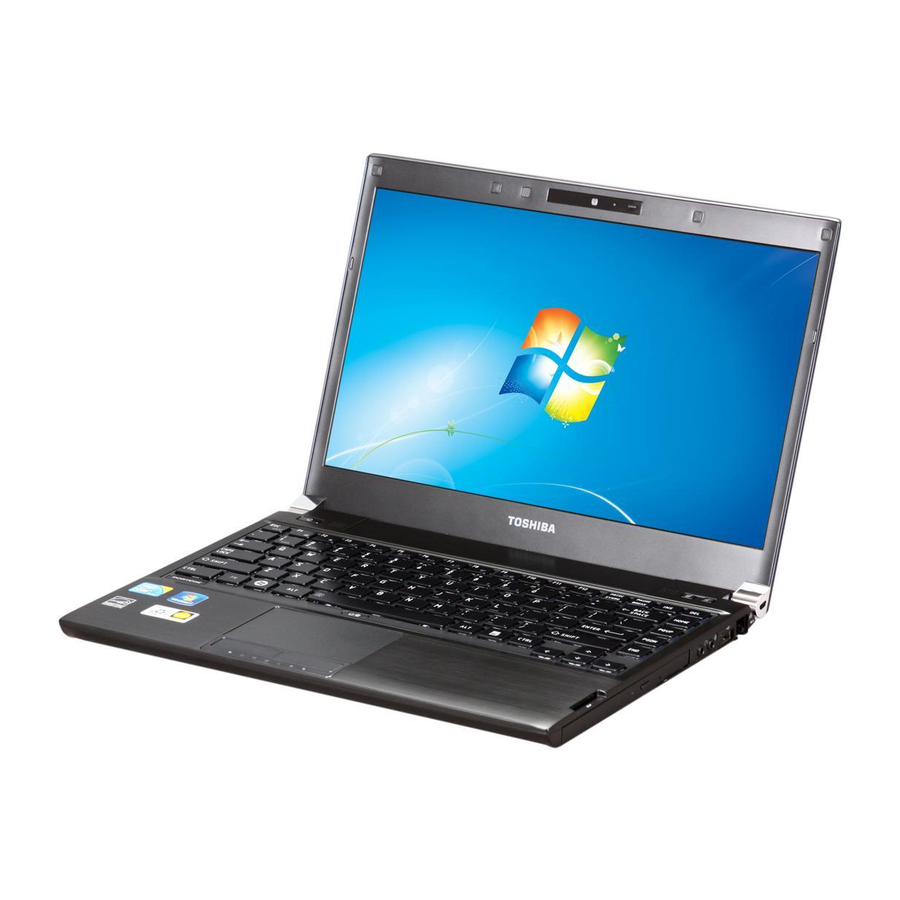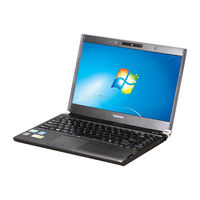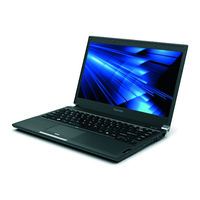
Toshiba PORTEGE R700 Series Manuals
Manuals and User Guides for Toshiba PORTEGE R700 Series. We have 6 Toshiba PORTEGE R700 Series manuals available for free PDF download: Maintenance Manual, User Manual, Specifications, Quickspecs
Toshiba PORTEGE R700 Series Maintenance Manual (474 pages)
Personal Computer
Table of Contents
-
-
Features15
-
Hdd&Ssd31
-
-
Sata Ssd33
-
-
Keyboard37
-
Power Supply39
-
Batteries42
-
AC Adapter45
-
-
-
-
Main Battery62
-
-
Troubleshooting108
-
-
Diagnostics Menu120
-
Heatrun Test130
-
Subtest Names131
-
System Test133
-
Keyboard Test136
-
Display Test137
-
Floppy Disk Test140
-
Printer Test142
-
Async Test144
-
Hard Disk Test145
-
Real Timer Test148
-
NDP Test150
-
Expansion Test151
-
Only One Test159
-
Operations159
-
Head Cleaning169
-
Operations169
-
Log Utilities170
-
Operations171
-
Operations172
-
Running Test172
-
Operations174
-
Operations179
-
LAN Test191
-
Bluetooth Test195
-
-
Main Menu199
-
Security Menu199
-
Advanced Menu200
-
Exit Menu201
-
-
Setup199
-
Outline207
-
Starting from CD208
-
Windows PE T&D210
-
Dos T&D256
-
Halt Operation264
-
-
-
-
Overview295
-
Battery Pack304
-
Figure304
-
Figure306
-
SIM Card306
-
Expresscard307
-
Figure307
-
Figure308
-
Memory Module309
-
Hdd/Ssd312
-
Base Assembly316
-
Expresscard Slot320
-
Battery Lock322
-
Card323
-
DC Fan334
-
E-SATA Board336
-
Fin338
-
Removing the Fin338
-
Bluetooth Module340
-
System Board342
-
Sound Board349
-
Speaker353
-
DC-IN Harness356
-
Keyboard361
-
Lcd369
-
Camera Module376
-
Hinge387
-
Appendices389
-
-
Appendix
391
Advertisement
Toshiba PORTEGE R700 Series User Manual (246 pages)
Toshiba Computer Drive User Manual
Table of Contents
-
Introduction37
-
This Guide39
-
Safety Icons40
-
-
-
Saving Your Work103
-
-
-
Battery Notice114
-
Power Management115
-
-
Traveling Tips131
-
-
-
TOSHIBA Assist145
-
Connect146
-
Secure147
-
Protect & Fix148
-
Optimize149
-
-
Mouse Utility160
-
-
-
Memory Problems184
-
Display Problems186
-
-
Error-Checking188
-
-
Printer Problems193
-
Modem Problems194
-
-
Hot Key Cards207
-
-
Card Case210
-
-
Volume Mute211
-
Power Plan213
-
-
Sleep Mode214
-
Hibernation Mode215
-
Numeric Overlay220
-
Toshiba PORTEGE R700 Series User Manual (198 pages)
Table of Contents
-
-
Precautions14
-
Conventions15
-
Preface15
-
Heat Injury18
-
-
-
Right Side37
-
Back40
-
Underside40
-
Indicators45
-
AC Adaptor50
-
-
-
PC Card67
-
Expresscard69
-
-
Web Camera95
-
-
Removing Discs102
-
-
Writing CD/Dvds104
-
Media Care114
-
Sound System115
-
Lan121
-
Taskbar Icon124
-
Details125
-
Heat Dispersal128
-
-
Typewriter Keys129
-
Hot Keys131
-
Fn Sticky Key132
-
-
Keypad Overlay133
-
Arrow Mode133
-
Numeric Mode133
-
-
-
-
Power Conditions136
-
Battery138
-
Power-Up Modes146
-
-
-
HW Setup Window148
-
Boot Priority149
-
Cpu149
-
Display149
-
Keyboard151
-
Usb151
-
Lan152
-
Sata152
-
Advanced153
-
-
-
-
Self Test157
-
System Start-Up157
-
Ac Power158
-
Real Time Clock160
-
Hard Disk Drive161
-
Pointing Device164
-
Touch Pad164
-
Usb Mouse165
-
Usb Device167
-
Esata Device169
-
Wireless Lan172
-
TOSHIBA Support173
-
Recovery Media173
-
-
-
-
Left Side35
-
Hardware52
-
General148
-
Video Mode176
-
-
Cpu190
-
Battery Life191
-
Lcd192
-
Wireless LAN192
-
Copy Protection193
-
Advertisement
Toshiba PORTEGE R700 Series User Manual (191 pages)
Toshiba Laptop User Manual
Table of Contents
-
-
-
PC Card60
-
Expresscard62
-
-
Memory Media64
-
-
-
Web Camera88
-
Media Care108
-
Sound System109
-
Lan115
-
Taskbar Icon118
-
Details120
-
Heat Dispersal122
-
-
Typewriter Keys123
-
Hot Keys125
-
-
Fn Sticky Key126
-
-
Keypad Overlay127
-
Arrow Mode127
-
-
-
Power Conditions129
-
Battery131
-
Power-Up Modes141
-
-
-
HW Setup Window143
-
General143
-
Display143
-
Cpu144
-
Boot Priority144
-
Keyboard146
-
Usb146
-
Sata147
-
Lan147
-
Advanced148
-
Troubleshooting149
-
-
Self Test152
-
System Start-Up152
-
Ac Power153
-
Real Time Clock155
-
Hard Disk Drive156
-
Pointing Device160
-
Touch Pad160
-
Usb Mouse161
-
Usb Device163
-
Esata Device166
-
Wireless Lan170
-
Recovery Media171
-
TOSHIBA Support171
-
Before You Call171
-
Where to Write171
-
-
Specifications172
Toshiba PORTEGE R700 Series Specifications (2 pages)
Ultra-mobile performance
Toshiba PORTEGE R700 Series Quickspecs (1 page)
Toshiba Oracle Portege R700 Quick specs
Advertisement





